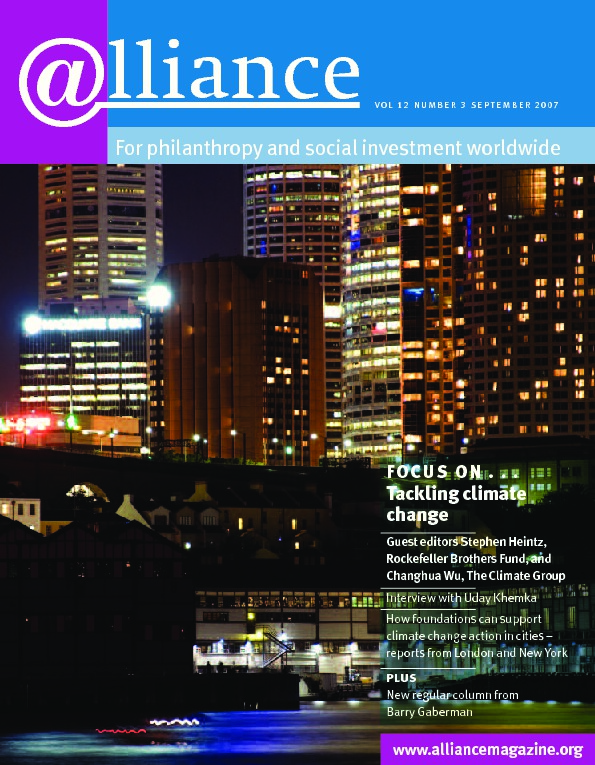In April, the Doris Duke Charitable Foundation created a $100 million programme to support research intended to encourage policies aimed at reducing the threat of global warming (see p27). Eric Heitz, president of the Energy Foundation, a partnership of US foundations that promote energy efficiency and renewable energy, is quoted in the Herald Tribune as saying this is a ‘very big deal’.
No doubt it is, but the Duke Foundation’s commitment, while sizable, is probably most significant for its focus. It reflects the growing interest of philanthropic bodies in promoting policies that tackle climate change.
In addition to the Duke programme, foundations like the Clinton Foundation are exploring the creation of foundation-business sector partnerships, while groups such as GEXSI (the Global Exchange for Social Investment), Ashoka, http://www.globalcool.org and the Ashden Awards are each exploring how best to support renewable energy projects in the developing world.
Another approach – neglected by the vast majority of foundations – would be to look at how to deploy capital from the corpus of their endowment in ways that would contribute to solving the global warming crisis. Moreover, this way of supporting initiatives to tackle climate change is open to all endowed foundations – indeed any organization with substantial assets to invest – whether they directly fund such initiatives or not.
Where to start?
If you are a foundation trustee or finance director, as ever the first principle is to ensure that suitable, independent and professional advice is sought (and documented), as any change in investment strategy could have an impact on the value of the foundation’s investments. Any re-evaluation of your investments could include the following steps.
Evaluate where your foundation’s portfolio is invested
Starting with equities, groups such as http://www.trucost.com can analyse whether your portfolio has a greater exposure to oil, coal and other fossil fuels compared to mainstream funds or the stock market as a whole – see http://www.websitepreview.co.uk/staging/trucost/carbon_news.html. It is also possible to undertake this analysis for individual portfolios – see http://www.websitepreview.co.uk/staging/trucost/carbonfootprint.html
Consider where more climate-friendly investment strategies fit
Investigate, if possible, where ‘positive’ strategies fit in with the overall purpose and risk of the foundation, not just offering philanthropic research into renewable energy (important as this is) but actually backing the commercial roll-out of these technologies. There is a growing number of funds which invest in renewable energy. Among the best known are the Black Rock New Energy Fund, whose assets have increased from $17.4 million three years ago to $2.6 billion, which invests in companies that produce energy from the sun, wind, oceans and farms; Impax Environmental Markets; and the Jupiter Ecology Fund, the longest-running UK green fund. There are now specialist private equity funds for renewables as well as renewable energy hedge funds.
Look at carbon trading and investment strategies
See, for instance, http://globalpensions.com/feature/feature_pdf_1159.pdf and consider the use of specialist research groups providing advice on this topic such as New Energy Finance.
Look where you bank
The recent report from Friends of the Earth in the Netherlands[1] comparing where banks lent their money raised a storm when it was launched, causing depositors to move to banks such as Triodos that avoid lending to the fossil fuel sector.
Invest in bonds linked to climate-friendly indices
There are now several of these. The most recent, from the European Investment Bank, linked to the FTSE4Good Environmental Leaders Europe 40 Index for New EIB Bond Issue, has proved to be particularly popular.[2]
Consider which advisers you use
Last September, Alliance reported the debate about whether financial advisers have the necessary skills to evaluate the impact of this new agenda upon how financial assets are invested. Now both Mercers and Watson Wyatt are vying to demonstrate to the market who has the best team on these topics, recruiting sustainability specialists from the SRI asset management community.
Subscribe to a specialist investment publication
Two good magazines that cover the environmental markets and the latest investment products and funds are the monthly Environmental Finance and the newer CleanTech Investor. You could also try http://www.EcoInvestor.com.au, which sends out a magazine in pdf format, and the US-based online news service at http://www.cleanedge.com.
For those foundations with substantial assets, join international collaborative initiatives around finance and climate change
The Carbon Disclosure Project (CDP) is an example of these. CDP provides a coordinating secretariat for institutional investors with a combined $41 trillion of assets under management. On their behalf, it seeks information on the business risks and opportunities presented by climate change and greenhouse gas emissions data from the world’s largest companies: 2,400 in 2007. Over seven years CDP has become the gold standard for carbon disclosure methodology and process. Its website is the world’s largest repository of corporate greenhouse gas emissions data. Other initiatives include CERES in the US, a national network of investors, environmental organizations and other public interest groups working with companies and investors to address sustainability challenges such as global climate change.
1 See http://www.milieudefensie.nl/klimaat/publicaties/rapporten/investinginclimatechange2007.pdf
2 See http://www.eurocharity.gr/en/article.php?article_id=1137
Mark Campanale is an investment manager at London Bridge Capital. He is writing in a personal capacity. Email mc@lbc.uk.net
For more information
‘Climate change has “no influence” on fund managers’, Environmental Finance, 7 June http://www.wbcsd.org/plugins/DocSearch/details.asp?type=DocDet&ObjectId=MjUwNTc
The Mission in the Marketplace: How responsible investing can strengthen the fiduciary oversight of foundation endowments and enhance philanthropic missions, Social Investment Forum Foundation, 2007. To download, click http://www.socialinvest.org/documents/MissioninMarketplace_000.pdf






Comments (0)